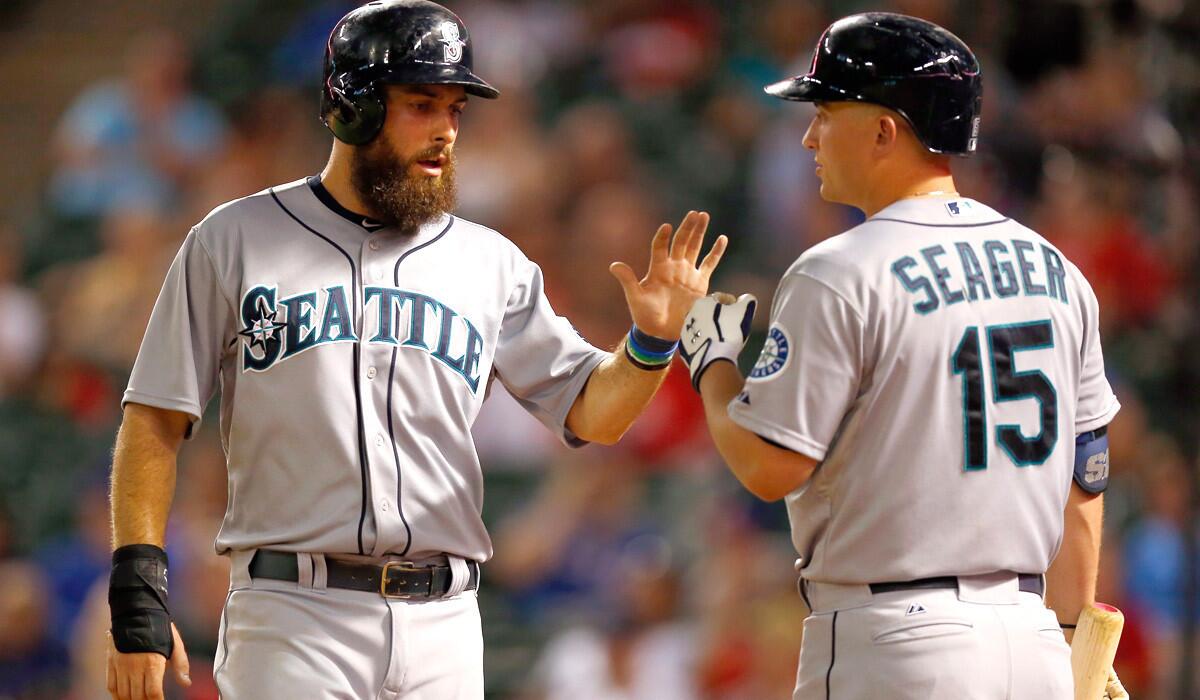Mariners are seriously angling for the playoffs

The Angels have the most victories in the major leagues and the second-place Oakland Athletics are leading the American League wild-card race. Yet, neither has been the best team in the AL West over the last five weeks.
Since July 26, no team in the division has played as well as the Seattle Mariners, who began play Saturday in position to earn their first postseason berth since Ichiro Suzuki’s rookie season. They’ve gotten there with phenomenal pitching, the kind that could pave the way for a lengthy playoff run.
“We’ve been thinking a long time about playoffs,” said Rick Waits, the Mariners’ first-year pitching coach. “A lot of times it doesn’t matter which team you beat or you don’t beat. And it doesn’t matter how you get in.
“The idea is to get in and then anything can happen. We feel very good about getting in and we feel very good about winning it all.”
That’s big talk coming from the only AL franchise that has never played in a World Series. But Waits’ team appears well armed to back that boast.
After running their winning streak to four games Friday with a victory over the Texas Rangers, the Mariners had a team earned-run average of 3.05 and a shot to become the first AL staff in four decades to finish a season below 3.00. Felix Hernandez (14-5, 2.18 ERA) and Hisashi Iwakuma (14-6, 2.97) give Seattle the only rotation in the AL with two starters with ERAs under 3.00. They’ve been complemented by Chris Young (12-7, 3.46) and a bullpen that has a big league-best 2.44 ERA and a league-low 10 blown save opportunities.
All of which explains why the Mariners are the team no one wants to face in the postseason, where pitching and defense typically rule.
First, of course, they have to get there.
The Mariners began the weekend third in the AL West, eight games back of the Angels with 22 to play, so a division title appears unlikely. But Seattle was right on the heels of Oakland and just ahead of Detroit in the battle for the league’s two wild-card berths.
That makes every game between now and the end of the season important for Seattle, which plays 10 of its final 22 games against the Angels and Oakland and has only seven games left against teams with losing records.
“The closer you get to the end of the season, each game is even more important. But they’re important now,” Waits said. “You’re going to need a certain amount of wins to get in. What is that number? I don’t know.
“We’ve got a lot of tough teams to play from here to the end.”
Seattle followed an unusual path to playoff contention. A year ago, the Mariners finished fourth in the division for the fourth year in a row and lost at least 90 games for the fourth time since 2008. They excelled at nothing, posting an ERA of 4.31, better than only four other teams, and finishing 28th among 30 teams in hitting with a .237 average.
So management cleaned house, sweeping out manager Eric Wedge and his coaching staff. Wedge was replaced by Lloyd McClendon, and a month later the Mariners moved to beef up their offense by signing free agent Robinson Cano to a 10-year, $240-million deal.
The pitching staff really didn’t come together until the spring, though, when Seattle signed former Angels closer Fernando Rodney and rescued Young, who had been released by Washington a week before opening day.
Before bonuses, those two moves will cost the team $8.25 million this season, or about a third of what Cano will get. But they’ve had a much bigger effect on the team’s success, because although Seattle’s offensive production has ticked up only slightly with Cano, the addition of the 35-year-old Young, a former All-Star pitching for his seventh organization, brought depth and experience to a rotation that has had 10 men make at least one start.
The bullpen’s transformation was even more dramatic. Seattle’s relief corps was the second-worst in the majors last season, but with Rodney, who began Saturday tied for the big league lead with 42 saves, at the back end, the Mariners have lowered their bullpen ERA by more than two runs. And after blowing nearly more than a third of their save chances in 2013, Seattle’s conversion rate of 82% is best in the AL. The staff is holding opponents to a .228 average, matching the lowest mark in the majors in at least a quarter-century.
Add in a defense that has the fewest errors in the league and is tied for the highest fielding percentage in the majors and General Manager Jack Zduriencik has finally made good on his promise to win with pitching and defense. Yet, even with the high-profile additions Seattle has made, Zduriencik turned the team around mainly with homegrown material. Fourteen of the 20 pitchers Seattle has used this season and six of its nine everyday players came up through the its system.
“Any good organization that wants to sustain playoff contention every year has to be build from within,” said Waits, who was the team’s minor league pitching instructor before being promoted to the major league staff. “It’s come together at the same time with the guys that we’ve been developing.”
Whether they’ve come far enough to get the Mariners into the playoffs remains to be seen. But if they make it, Waits likes their chances.
“I know we’re good. I know we’re not going to give any games away,” he said. “We’re not afraid to put anybody in there at any time. Let’s just play the games and see how it goes.”
More to Read
Go beyond the scoreboard
Get the latest on L.A.'s teams in the daily Sports Report newsletter.
You may occasionally receive promotional content from the Los Angeles Times.











